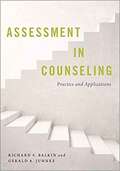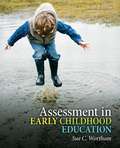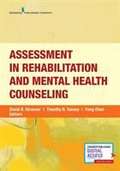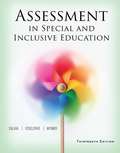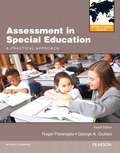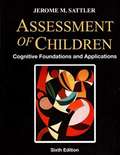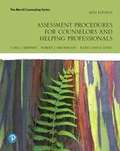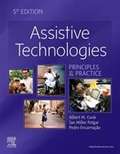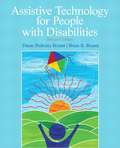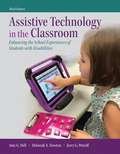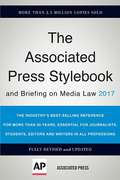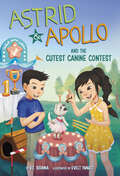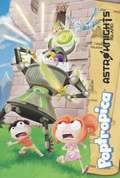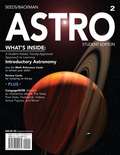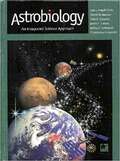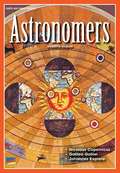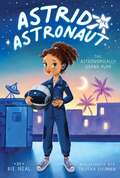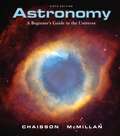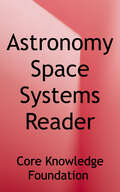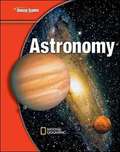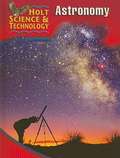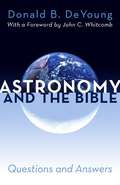- Table View
- List View
Assessment in Counseling: Practice and Applications
by Richard S. Balkin Gerald A. JuhnkeStudents often experience assessment courses, and subsequently the textbooks used for the course, as a statistics-heavy class accompanied by an encyclopedia of a variety of assessments. Assessment in Counseling alternatively emphasizes the skills used in assessment, thereby enabling students to apply these skills across a broad range of assessment instruments and strategies. Assessment, like most core areas of counseling, has a theoretical basis and a pertinent, practical component. However, this practical component often gets lost in the application of the skills and use of instruments that heavily rely on psychometric properties. <p><p> Written in an accessible, conversational tone, this text focuses on the application of the theoretical and measurement concepts of assessment in counseling and introduces three case studies that are followed throughout the text. Additionally, instead of introducing readers to a plethora of instruments, the authors select seminal measures that students are likely to approach and use in the profession. Through the use of this text and course content, one will acquire the skills to search, select, and administer the type of assessment instruments that he/she deems helpful for their practice as a professional counselor, regardless of specialization. Ultimately, this textbook serves as an invaluable guide for administering, scoring, interpreting, and communicating assessment results.
Assessment In Early Childhood Education (Sixth Edition)
by Sue C. WorthamWritten for preschool and primary school teachers involved in preparing for, administering, interpreting, and moving forward with the results of informal and standardized testing, Wortham's Assessment in Early Childhood Education, Sixth Edition, is one of the most accessible and practical books available in measurement and evaluation examines both standardized and informal assessment tools from a developmental perspective, focusing entirely on children between birth and age eight. Key changes to this edition include: a new emphasis on building partnerships with families with the inclusion of a diverse array of parents and families as examples; revised and expanded information on children from diverse cultures and languages and children with disabilities; updated and streamlined figures, examples, and models of assessment are found throughout the text; activities at the end of the chapters provide opportunities for students to apply their own performance activities and demonstrate understanding of chapter content; updated content on the effects of No Child Left Behind; and new information on current trends toward accountability and the impact of high-stakes testing.
Assessment In Rehabilitation And Mental Health Counseling
by David R. Strauser Timothy N. Tansey Fong ChanThis graduate-level text on rehabilitation and mental health counseling disseminates foundational knowledge of assessment principles and processes with a focus on clinical application. Written by recognized leaders in rehabilitation and mental health, it is the only book to use the World Health Organization's International Classification of Functioning, Disability and Health (ICF) framework to integrate assessment tools and techniques addressing practice with varied populations and settings. <p><p> Written by leading practitioners with specialized knowledge, chapters focus on specific populations and service delivery settings. The book features a variety of learning tools to foster critical thinking, including learning objectives and case examples highlighting important principles and applications. Sample reports and templates further reinforce understanding of specific applications.
Assessment in Special and Inclusive Education
by John Salvia James Ysseldyke Sara BoltASSESSMENT IN SPECIAL AND INCLUSIVE EDUCATION offers you basic assessment information along with a handbook-style reference to comprehensive, frank reviews of the tests most commonly administered in K-12 schools. The thirteenth edition brings to the forefront the important topics of MTSS/RTI and ELL, while retaining key features that have made the text a classic. The authors include a focus on both classroom-based tests designed to inform instruction and intervention, as well as more formal standardized tests that are commonly used to determine eligibility for special education. Whether you are a novice or an expert, this text will equip you with the knowledge and tools to effectively and efficiently assess your students' skills and abilities. Featuring an emphasis on improved outcomes, it shows you how to go beyond efforts designed to make predictions about students' lives to efforts that can make a difference in the lives of the students you serve.
Assessment in Special Education: A Practical Approach (Fourth Edition)
by Roger Pierangelo George A. GiulianiThe fourth edition of Assessment in Special Education covers assessments for every disability type while examining each stage of the assessment process. Chapters discuss the most current and reliable assessment measures used in schools to determine all areas of special need from infancy, to school-age and into adulthood. This book addresses current topics such as IDEIA, curriculum-based assessment, curriculum-based measurement, functional behavior assessments and behavioral intervention plans.
Assessment Of Children: Cognitive Foundations And Applications
by Jerome M. SattlerThis volume provides extensive tables to help in interpreting the WISC-V, WPPSI-IV, SB5, DAS-II, and WJ IV COG. It also contains appendixes focusing on laws pertaining to children with special needs (IDEA, Section 504, and ADA), testifying as an expert witness, and test reviews.
Assessment Procedures For Counselors And Helping Professionals
by Robert Drummond Carl Sheperis Karyn JonesSince its first publication in 1988, Assessment Procedures for Counselors and Helping Professionals has become a classic among assessment textbooks designed specifically for aspiring counselors. Now in its 9th Edition, the text includes extensive changes to content and updating throughout, while maintaining its popular, easy-to-read format and continuing emphasis on assessment information that is most useful and relevant for school counselors, marriage and family therapists, mental health counselors, and other helping professionals. Throughout the text, readers get invaluable information and examples about widely used assessment instruments in order to become familiar with these well-known tests.
Assistive Technologies: Principles And Practice
by Albert M. Cook Janice Miller Polgar Pedro EncarnaçãoMaster the assistive strategies you need to make confident clinical decisions and help improve the quality of life for people with disabilities. Based on the Human Activity Assistive Technology (HAAT) model developed by Al Cook, Sue Hussey and Jan Polgar, Assistive Technologies: Principles & Practice, 5th Edition, provides detailed coverage of the broad range of devices, services, and practices that comprise assistive technology. This new text offers a systematic process for ensuring the effective application of assistive technologies - and focuses on the relationship between the human user and the assisted activity within specific contexts. It features over 30 new photos and illustrations, as well as, updated chapters and case studies that reflect current technology.
Assistive Technology For People With Disabilities (Second Edition)
by Diane Pedrotty Bryant Brian R. BryantAssistive Technology for People with Disabilities, Second Edition, includes eight comprehensive chapters that focus on devices and software to enhance the lives and promote the independence of people with disabilities. Updated with new research, content and features to address current developments in the field, the book approaches assistive technology and education in a lifespan, multidisciplinary manner by discussing the use of current technology in the fields of special education, rehabilitation, speech-language pathology, and other disciplines. Featured devices and software will help you understand how areas such as mobility, communication, education, independent living, and access to information media affect learning and living for individuals with disabilities. You will also gain a great understanding of the foundational and historical perspectives of AT, assessment, universal design, and the ADAPT framework, which is a tool to help educators make decisions about appropriate AT, student needs, and the demands of the environment. Developed from the authors' years of experience teaching both K-12 students and adults, as well as their own framework for understanding assistive technology application and integrating technology into instruction, this new edition addresses assistive technology that promotes knowledge and skills, practical application and a myriad of opportunities that good technology provides for persons with disabilities.
Assistive Technology in the Classroom: Enhancing the School Experiences of Students with Disabilities (Third Edition)
by Amy G. Dell Deborah A. Newton Jerry G. PetroffWith an emphasis on the integration of assistive technology into the curriculum, this text focuses on how assistive technology can be used in schools to enhance the teaching and learning of students with disabilities. This link between technology and teaching and learning drives the book's organization as well as its content. It is organized by school-related tasks that students must perform on a daily basis to be successful -- reading, writing, practicing academic skills, and communicating with their teachers and peers – and presents descriptions of technology-based solutions to the obstacles students with disabilities face in completing these tasks. Since being able to access computers is one major barrier, the text features a section on making computers accessible to students with a wide range of disabilities. A companion web site offers up-to-date information on product names, vendors, web site addresses, and other time-sensitive material.
The Associated Press Stylebook 2017 and Briefing on Media Law
by Associated Press StaffThe style of the Associated Press is the gold standard for news writing. With The AP Stylebook in hand, you can learn how to write and edit with the clarity and professionalism for which they are famous. Fully revised and updated, this new edition contains more than 3,000 A to Z entries--including more than 200 new ones--detailing the AP's rules on grammar, spelling, punctuation, capitalization, abbreviation, and word and numeral usage. You'll find answers to such wide-ranging questions as: � When should the names of government bodies be spelled out and when should they be abbreviated? � What are the general definitions of the major religious movements? � Which companies do the big media conglomerates own? � Who are all the members of the British Commonwealth? � How should box scores for baseball games be filed? � What constitutes "fair use"? � What exactly does the Freedom of Information Act cover? With invaluable additional sections on the unique guidelines for business and sports reporting and on how you can guard against libel and copyright infringement, The AP Stylebook is the one reference that all writers, editors, and students cannot afford to be without.
Asteroid, Meteoroid, and Comet Facts (Into Reading, Level T #76)
by Bruce NaylorNIMAC-sourced textbook
Astonishing Nature: Forces of Nature Unit 4
by McGraw-HillHow does Earth change? Earth is constantly changing. Scientists study all parts of what makes our planet survive, thrive, and adapt. It is important for us to know and predict patterns that affect Earth so that we can protect it. It is also important for us to understand the natural forces that affect Earth. The more we know, the more we can do to help preserve our planet.
Astrid and Apollo and the Cutest Canine Contest (Astrid and Apollo)
by V.T. BidaniaEight-year-old Hmong American twins Astrid and Apollo decide to enter their dog Luna in the Cutest Canine Contest. After all, she’s the cutest dog they know! But they discover that teaching Luna the tricks needed to compete in the contest might be “trickier” than they thought! With the help of a friend and little sister Eliana, they discover Luna is a fast learner—but that she’s also picked up some bad habits from another dog! On the day of the contest, will Luna dazzle or fizzle? Exploring themes of tradition and adventure, and showcasing a warm sibling relationship in a Hmong American family, Astrid and Apollo will charm young readers.
Astro-Knights Island (Poptropica)
by Madpark Design Inc. Tracey WestWhen the princess of the kingdom of Arturus is kidnapped and taken into space by an evil inventor named Mordred, Simon and Alice must learn to build their own spacecraft and travel the stars to rescue the princess.
Astro2
by Michael A. Seeds Dana BackmanCreated through a "student-tested, faculty-approved" review process, ASTRO 2e is an engaging and accessible solution to accommodate the diverse lifestyles of today's learners. ASTRO 2e employs the same engaging writing style that has become a hallmark of Mike Seeds and Dana Backman's introductory astronomy texts.
Astrobiology: An Integrated Science Approach
by Jodi E. Asbell-Clarke Daniel W. Barstow Teon E. Edwards James L. Larsen [et al.]Astrobiology: An Integrated Science Approach
Astronomers: Set of 6 (Navigators Ser.)
by Roberta Silman Alison Adams Albert HannerNIMAC-sourced textbook
The Astronomically Grand Plan (Astrid the Astronaut #1)
by Rie NealIn this first book of a brand new-chapter book series, a young girl is determined to be the first astronaut with hearing aids in space!Astrid can&’t wait for the school year to start so she can put her Astronomically Grand Plan into action! She and her best friend, Hallie, are going to be in their first year of Shooting Stars, a club dedicated to all things space. Astrid&’s big sister has told her all about it, and this year, there is a big, wonderful prize: a trip to a real-life space camp! But Astrid&’s Grand Plan isn&’t off to a great start: it turns out Hallie is more interested in the art club, Petite Picassos! And Astrid isn&’t sure that her goal of exploring space will happen the same way without her BFF by her side. Can Astrid figure out a way to complete her mission?
Astronomy: A Beginner's Guide to the Universe (5th edition)
by Eric Chaisson Steve McmillanAstronomy: A Beginner's Guide to the Universe has been written and designed for students who have taken no previous college science courses and who will likely not major in physics or astronomy. The book presents a broad view of astronomy, straightforwardly descriptive and without complex mathematics.
Astronomy: Space Systems
by Core Knowledge FoundationAstronomy: Space Systems introduces Grade 5 students to real-world examples and fundamental concepts that will be explored in greater depth in later grades. <p><p>Students will learn about the system of planets that orbit our sun. introduces gravity as a pull “downward” toward the center of Earth. Students read about the brightness of stars and the relationship between distance and absolute brightness. They will read about and investigate patterns of day/night, shadow movement, and seasonal changes.
Astronomy
by Glencoe Mcgraw-HillDiscover the Flexibility to Teach Science Your Way!. "Glencoe Science: Astronomy," a module in the Glencoe Science 15 book series, provides students with accurate and comprehensive coverage of middle school National Science Education Standards. Concepts are explained in a clear, concise manner, and are integrated with a wide range of hands-on experiences, critical thinking opportunities, real-world applications, and connections to other sciences and to non-science areas of the curriculum. Co-authored by National Geographic, unparalleled graphics reinforce key concepts. A broad array of print and technology resources help differentiate and accommodate all learners. The modular approach allows you to mix and match books to meet your specific curriculum needs.
Astronomy: Holt Science & Technology Short Course J
by Holt Rinehart WinstonThe book has a Reading Warm-Up at the beginning of every section provides the student with the section's objectives and key terms. A Reading Strategy at the beginning of every section provides tips to help students organize and remember the information covered in the section.
Astronomy and the Bible: Questinons and Answers
by Donald B. DeYoung John C. WhitcombAstronomy and the Bible is a 155-page paperback which answers 100 intriguing questions about astronomy and science. Written by Grace College professor Dr. Don B. DeYoung, it is subtitled Questions and Answers. The questions range across subjects such as the earth and the moon, the solar system, the stars, galaxies and the universe, and general science. Published by BMH Books, Winona Lake, Ind., the book includes a new, helpful series of seasonal star charts for the Northern Hemisphere, along with a general and a scripture index. DeYoung, who has taught at Grace College since 1972, is known internationally for his work in creation science. He is president of the Creation Research Society and is the author of 17 books, including Pioneer Explorers of Intelligent Design, also published by BMH books. He and his wife, Sally, are members of the Winona Lake (Ind.) Grace Brethren church. Astronomy and the Bible's question-and-answer format makes it a practical tool for the classroom and home school.

